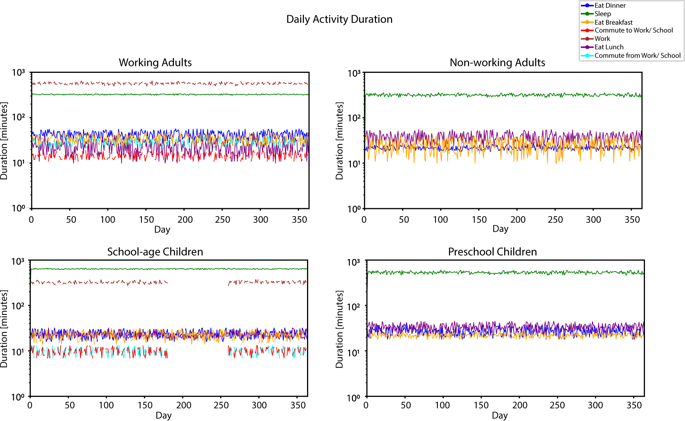当前位置:
X-MOL 学术
›
J. Expo. Sci. Environ. Epid.
›
论文详情
Our official English website, www.x-mol.net, welcomes your
feedback! (Note: you will need to create a separate account there.)
Calibrating an agent-based model of longitudinal human activity patterns using the Consolidated Human Activity Database.
Journal of Exposure Science and Environmental Epidemiology ( IF 4.1 ) Pub Date : 2019-07-10 , DOI: 10.1038/s41370-019-0156-z Namdi Brandon 1 , Paul S Price 1
Journal of Exposure Science and Environmental Epidemiology ( IF 4.1 ) Pub Date : 2019-07-10 , DOI: 10.1038/s41370-019-0156-z Namdi Brandon 1 , Paul S Price 1
Affiliation

|
Patterns of human behavior over extended periods of time are important for characterizing human exposure to hazardous chemicals. Because longitudinal behavior patterns for an individual are difficult to obtain, exposure-assessors have characterized such patterns by linking daily records from multiple individuals. In an earlier publication, we developed an alternative strategy that was based on agent-based simulation modeling. Specifically, we created a software program, Agent-Based Model of Human Activity Patterns (ABMHAP), that generates year-long longitudinal behavior patterns. In this paper, we both calibrate and evaluate ABMHAP using human behavior data from the U.S. Environmental Protection Agency's Consolidated Human Activity Database (CHAD). We use the longitudinal data (data on individuals' activities over multiple days) in CHAD to parameterize ABMHAP, and we use single-day behavior data from CHAD to evaluate ABMHAP predictions. We evaluate ABMHAP's ability to simulate sleeping, eating, commuting, and working (or attending school) for four populations: working adults, nonworking adults, school-age children, and preschool children. The results demonstrate that ABMHAP, when parameterized with empirical data, can capture both interindividual and intraindividual variation in behaviors in different types of individuals. We propose that simulating annual activity patterns via ABMHAP may allow exposure-assessors to characterize exposure-related behavior in ways not possible with traditional survey methods.
中文翻译:

使用综合人类活动数据库校准基于代理的纵向人类活动模式模型。
人类在较长时间内的行为模式对于表征人类接触危险化学品的情况非常重要。由于个体的纵向行为模式很难获得,暴露评估者通过链接多个个体的日常记录来表征这种模式。在早期的出版物中,我们开发了一种基于代理的模拟建模的替代策略。具体来说,我们创建了一个软件程序,即基于代理的人类活动模式模型(ABMHAP),它可以生成长达一年的纵向行为模式。在本文中,我们使用美国环境保护局综合人类活动数据库 (CHAD) 中的人类行为数据来校准和评估 ABMHAP。我们使用 CHAD 中的纵向数据(有关个人多日活动的数据)来参数化 ABMHAP,并使用 CHAD 中的单日行为数据来评估 ABMHAP 预测。我们评估 ABMHAP 模拟四种人群的睡眠、饮食、通勤和工作(或上学)的能力:工作成年人、非工作成年人、学龄儿童和学龄前儿童。结果表明,当用经验数据进行参数化时,ABMHAP 可以捕获不同类型个体的个体间和个体内行为差异。我们建议,通过 ABMHAP 模拟年度活动模式可能会让暴露评估者以传统调查方法无法实现的方式来描述与暴露相关的行为。
更新日期:2019-11-18
中文翻译:

使用综合人类活动数据库校准基于代理的纵向人类活动模式模型。
人类在较长时间内的行为模式对于表征人类接触危险化学品的情况非常重要。由于个体的纵向行为模式很难获得,暴露评估者通过链接多个个体的日常记录来表征这种模式。在早期的出版物中,我们开发了一种基于代理的模拟建模的替代策略。具体来说,我们创建了一个软件程序,即基于代理的人类活动模式模型(ABMHAP),它可以生成长达一年的纵向行为模式。在本文中,我们使用美国环境保护局综合人类活动数据库 (CHAD) 中的人类行为数据来校准和评估 ABMHAP。我们使用 CHAD 中的纵向数据(有关个人多日活动的数据)来参数化 ABMHAP,并使用 CHAD 中的单日行为数据来评估 ABMHAP 预测。我们评估 ABMHAP 模拟四种人群的睡眠、饮食、通勤和工作(或上学)的能力:工作成年人、非工作成年人、学龄儿童和学龄前儿童。结果表明,当用经验数据进行参数化时,ABMHAP 可以捕获不同类型个体的个体间和个体内行为差异。我们建议,通过 ABMHAP 模拟年度活动模式可能会让暴露评估者以传统调查方法无法实现的方式来描述与暴露相关的行为。











































 京公网安备 11010802027423号
京公网安备 11010802027423号